Irish soda bread is so quick and easy. It’s perfect whenever you want a loaf of homemade bread for brunch or dinner. Try all five flavor options!
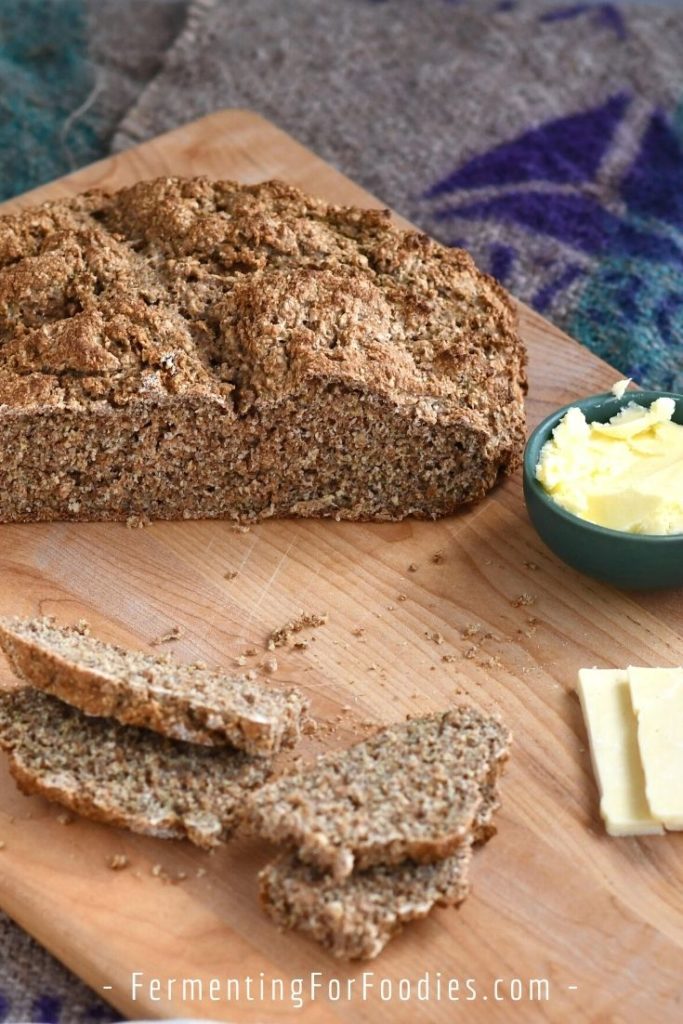
I first learned to make soda bread while living in Ireland, where bread usually comes in two forms: a soft white “batch” bread and a hearty brown soda bread. Soda bread is so ubiquitous that baking soda is actually called bread soda in the supermarket!
Traditional Irish soda bread is delicious served with butter next to a bowl of soup or Irish stew. Best of all, the leftovers are perfect toasted for breakfast.
Five Flavor Options
I went through a period of making soda bread nearly once a week. It was my go-to solution whenever we were having soup or stew for dinner. So spent quite a bit of time playing with different flavor options.
Here are five flavors that we love.
1. Brown bread:
Traditional Irish soda bread, the sort that is served in most pubs and restaurants, is earthy, warm, and wholesome.
- To make brown bread use 100% wholewheat flour and add in 1/4 cup of cracked wheat.
2. Seedy loaf:
Seedy soda bread is my favorite. I love the crunch of toasted seeds. It’s perfect next to a bowl of cream of vegetable soup.
- To make a seedy loaf, make the bread with either whole wheat or white flour.
- Add 1/4 cup of sunflower seeds, 2 Tbsp flax seeds, and 2 Tbsp poppy seeds into the batter.
- Before baking, top the loaf with a sprinkling of sesame, flax, and poppy seeds.
3. Lemon pepper loaf:
Lemon pepper loaf is a unique dinner loaf. The flavor combination works amazingly well with soda bread.
- To make lemon pepper loaf add 3/4 cup of grated cheddar cheese, 1 Tbsp of chopped chives, 2 tsp of freshly ground black pepper, and 1 tsp of lemon zest to the batter.
- Top the loaf with cheese prior to baking.
4. Rosemary cheese loaf:
Rosemary cheese loaf is an excellent dinner bread. It can also be toasted for garlic bread.
- To make rosemary cheese loaf, dice a small onion and saute until softened.
- Add the softened onion to the batter along with 3/4 cup grated Parmesan cheese, and 2 Tbsp finely diced fresh rosemary.
- Top the loaf with 2 Tbsp of grated Parmesan cheese.
5. Cinnamon Raisin loaf:
Cinnamon raisin soda bread is a sweet breakfast loaf. It is absolutely amazing toasted with butter.
- To make a cinnamon raisin loaf, add 3/4 cup of small raisins or currants, 1/4 cup of sugar, and 1 Tbsp of cinnamon to the batter.
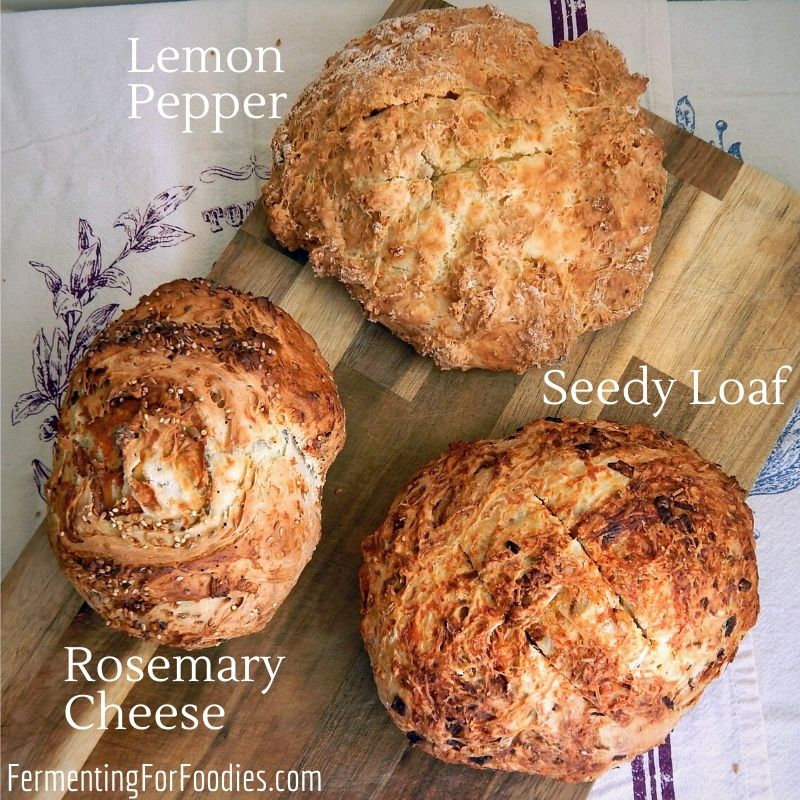
Traditional Irish soda bread
Traditional Irish soda bread is deliciously quick and easy to make. It is perfect next to a bowl of stew or toasted for breakfast. See the section above for 5 flavor options.
- Prep Time: 10 minutes
- Cook Time: 30 minutes
- Total Time: 40 minutes
- Yield: 1 loaf 1x
- Category: Bread
- Cuisine: Irish
- Diet: Vegetarian
Ingredients
- 3 cups of flour (400g)
- 1 2/3 cups buttermilk (400 g, see below for alternatives)
- 1 tsp salt
- 1 tsp baking soda
- Additional flavors (see section above for suggestions)
Instructions
- Combine the buttermilk and flour in a large bowl, and leave it to hydrate for 5 minutes. Feel free to use whole wheat or all-purpose flour.
- Sprinkle the dough with salt and soda then mix well. You don’t want any clumps of baking soda! Stir in any additional flavors.
- Scrape the dough onto a greased baking sheet or cooking stone. Irish soda bread is typically baked in a free-form ball.
- Slice a cross into the top of the loaf about 3/4-inch deep. If you want to add a topping, brush the top of the loaf with beaten egg, milk, or water then sprinkle on the topping.
- Bake at 400F for 30-40 min (until a toothpick comes out clean).
Notes
- Though buttermilk is traditional, feel free to use other types of soured dairy milk. Milk kefir and plain yogurt (with no thickeners) both work equally well. Avoid Greek yogurt (strained yogurt) or yogurt that contains thickeners. You need liquid for this recipe.
- For a delicious gluten-free option, here is my recipe for gluten-free soda bread.
Nutrition
- Serving Size: 1 slice whole wheat bread
- Calories: 127
- Sugar: 1.7g
- Sodium: 334mg
- Fat: 0.6g
- Saturated Fat: 0.2g
- Carbohydrates: 25.5g
- Fiber: 0.8g
- Protein: 4.4g
- Cholesterol: 1mg
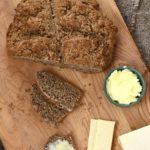
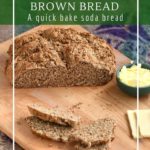
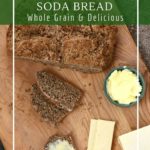
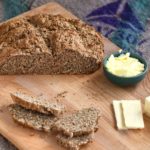
I used kefir instead of buttermilk. Otherwise, just as written. I did toss a handful of raw sunflower seeds into the dough. WOW this came out so perfect. Haven’t had such nice soda bread since I was in Wexford.
I always use kefir too. 🙂 But buttermilk is traditional. Glad you liked it! Learned the recipe while living in Kildare. So it’s authentic!
I’ve made this recipe twice now and both times the batter has been like soup. You say it can be baked free form on a pan but with the consistency of the dough there is no way that’s possible. Scoring is also a challenge because of course it can’t hold it’s shape. I also have to cook this loaf for 1.5 hours. Please tell me what I am doing wrong?
That is surprising because this is one of the recipes I make over and over again. I think you might need just a bit more flour? Try adding an extra 1/4 to 1/2 cup. Different flours have different hydration ratios, so maybe that’s it? In general, white bread flour absorbs the most liquid and whole-grain flours absorb less.
It won’t become a firm ball like traditional bread dough. However, it should be able to form a soft ball of dough. Good luck!
Can you please explain how to make a fermented loaf of Irish soda bread? I clicked on the link in the notes section taking about fermentation and It took me to a sourdough recipe and I still don’t understand what to do. Thank you
The buttermilk is used to ferment the flour. Soaking the flour in buttermilk for 24 hours will result in a thick and sour gluten structure that is unlike typical soda bread. The link for the pincer method is supposed to help with adding the remaining ingredients.
I’ll take a look at this today, and see if I can rewrite it for clarity. Cheers!
Delicious! I made the cinnamon raisin variation & loved that it was not super sweet. I used some kefir that had turned to curds & regular kefir. Great recipe & excited to try the variations.
Great!
For your English fans could you put measurements in 1lbs and ounces please
Hi Wendy, I just finished writing a cookbook, and my publisher had me include metric and imperial for all measurements so I’m now practiced at converting! Will do this today. Cheers, Emillie
So just a question more than a review, my dough came out really super wet, like almost soupy. Should I add just a touch more flour? We live in a humid climate, just moved here from Colorado so I’m having to relearn how to bake at sea level and with humidity. I’m waiting on the results as I write this, but it didn’t get much oven spring
That is surprising! It isn’t a dry, bread-like dough. But it should be drier than muffin batter. At least dry enough to hold a rough, loaf-like shape. The moisture will also depend on the type of flour. Whole grain flours don’t tend to absorb as much moisture as white flour. So you may need to adjust.
However, in general, this loaf should work in a humid environment. I used to make it all the time in Ireland, which is quite humid. Colorado is also quite high above sea level, so that would also have affected your baking. (I have an Uncle in Boulder). Cheers!
Some of your readers may be having problems with this due to the flour they are using.
European flours, including on the island of Ireland, tend to be soft flowers, while in N. America, hard flowers. When we came to Canada, my mom would mix in Graham Flour to compensate.
But now, while expensive, you can often source Irish flours at some specialty shops, which may give a better result.
Interesting! Thanks for sharing.
You’re very welcome! I have researched this, a lot, noting the differences between a “Northern Irish Soda Farl” and then trying to replicate it with Canadian wheat.
With a cake and pastry flour from Canada, it’s much closer 🙂
It is the same with Irish Wheaten.
The liquid AND the rising agent of an acid with baking soda and the end result will be greatly affected by the wheat flour you are using, as well as liquid absorption.
My Irish granny used to be an amazing soda far and wheaten bread maker and passed things on… 🙂
But yes, the wheat flour you are using can make a world of difference. North American “All Purpose Wheat” makes some really amazing yeast fermented breads… more protein and the longer it’s yeast fermented, the better, but can sometimes cause issues with both soda/acid risings and how the deal with liquid measurements.
But nonetheless… thank you for sharing the breads of my home! 🙂
Your comment was caught by the spam filter, but I tend to check the trash anyway. 🙂 We lived in Maynooth for several years, which is where I picked up the soda bread habit. I find that using whole wheat with cracked wheat is the most similar to the brown bread that was served in most pubs. But I hadn’t considered the protein content of white flour. Thanks for sharing! Cheers, Emillie
I use Morton’s soda bread flour but it says use buttermilk we have kefir yogurt here which is thick in spain how what do I use to make it thinner for 1/2pint it’s 450 grms flour 280 mls milk thks
Sorry for the slow reply. I was camping in an area without mobile coverage. 🙂 I recommend making the bread following the recipe exactly, then adding more water if needed. I’m not sure how thick the kefir is. However, it will work! I use my homemade milk kefir instead of buttermilk all the time. Cheers!